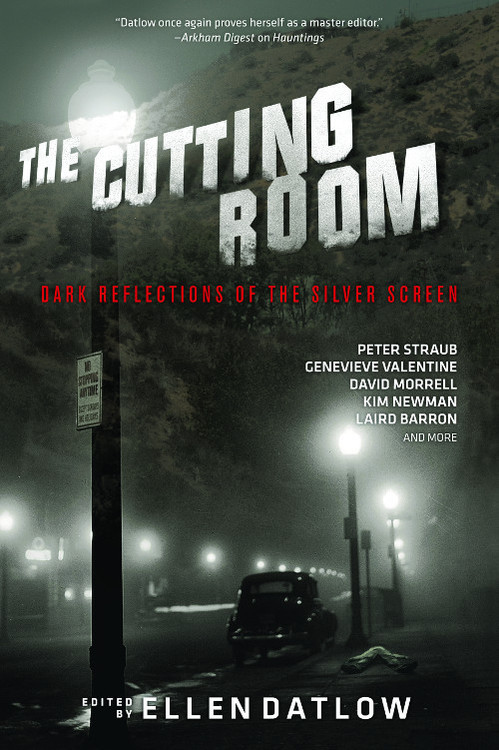THE CUTTING ROOM coming attraction: “Filming the Making of the Film of the Making of Fitzcarraldo” by Garry Kilworth

Over the next two weeks, in celebration of Halloween and the new anthology The Cutting Room: Dark Reflections of the Silver Screen, Tachyon and editor Ellen Datlow present excerpts from a selection of the volume’s horrifying tales.
Today’s selection comes from “Filming the Making of the Film of the Making of Fitzcarraldo” by Garry Kilworth.
He told me his name was Cartier and we arranged a meeting at once, in a café on the Boulevard St. Augustin. He was a small, thickset man with dark features and an Eskimo’s eyes. He claimed to be a Canadian and spoke a form of French that I had to translate mentally into the purity of my own tongue. His story essentially involved three people—himself, a man called McArthur, and McArthur’s niece, a twenty-year-old called Denise. Somehow—this was never fully explained—Cartier got wind of the filmmaker Werner Herzog’s decision to make the movie Fitzcarraldo and the three of them followed Herzog and his crew to the South American jungles, determined, clandestinely, to film the German at work.
I ordered cognacs, before Cartier got too involved with his story, and we waited for a few moments, watching the Parisian passersby, until the drinks were on the table. I then signalled for Cartier to continue.
“We pooled our money—all we had—and set off in pursuit of Herzog’s crew. It might seem, now, that taking Denise with us was a bad decision, but she absolutely worshipped McArthur and unfortunately most of the money came from her. Anyway, McArthur had always been strong on family, you know. He wasn’t married and his parents were dead. His sister, to whom he had always been close, was working somewhere in Asia. So he felt it was his duty to include his niece, her daughter, in the expedition, if that’s what she wanted.”
It was with intense annoyance (a mild word, I should have thought) that Cartier and McArthur realised an official movie of the making of the film was already in progress. In fact it was this second crew that he and McArthur had to shoot, since this party remained a barrier between Herzog’s main crew and Cartier’s secret camera.
“Denise stayed well behind at this stage, in a second canoe, but McArthur and I disguised ourselves as Indians and followed at a distance as they went upriver. McArthur had the camera in the nose of our canoe, camouflaged with reeds. In any case, we were quite a way behind and we had our Indians, who waved to those in front. We hoped they would just think us curious natives.”
The Cartier-McArthur camp was established a little downriver from the other two crews, and on the opposite bank, their movements hidden by the thick foliage of the rainforest.
“The Indians helped us to make some huts out of the broad-leafed plants. They weren’t much, but they provided shelter from the tropical rain. McArthur was like a schoolboy at first. Everything excited him—the jungle life, especially. He had a new single-reflex stills camera—with a close-up lens—and he photographed anything that buzzed, croaked, or hissed. The place was teeming with life. It got into all the equipment and our clothes. The only things McArthur wasn’t too fond of were the snakes and spiders. His phobias were very suburban.
“Denise, on the other hand, was contemptuous of everything in the rain forest. She showed neither interest in any creature, nor fear. I personally believe she was utterly incapable of being fascinated. That is, she saw no magic in this quite extraordinary world, only squalor. To her there were only two kinds of creature, in myriad shapes—‘slimes’ and ‘crawlers.’ Oh, she knew the names for them all right, but she just wasn’t going to waste her time finding the right word. That would have meant giving them a specific identity, acknowledging that they were even of minor importance to her, personally.
“All Denise was interested in was getting the job done. She didn’t like me very much either. I think I was a ‘crawler.’ And she was forever pestering me. One morning I had the camera in pieces—the spare wasn’t working either.
“‘Can I help?’ she asked, but wearing one of those wooden expressions that I hated. She had several facial masks which were designed to keep me at a distance and in my place.
“‘Yeah—you can scratch my insect bites,’ I told her. ‘They’re killing me.’ I lifted my shirt to show her three or four large red lumps on my stomach.
“She didn’t even say, ‘You’re disgusting,’ or anything like that. She merely looked at me blankly and remarked, ‘I mean with the camera.’
For information on The Cutting Room: Dark Reflections of the Silver Screen, visit the Tachyon page.
Cover by Josh Beatman.
